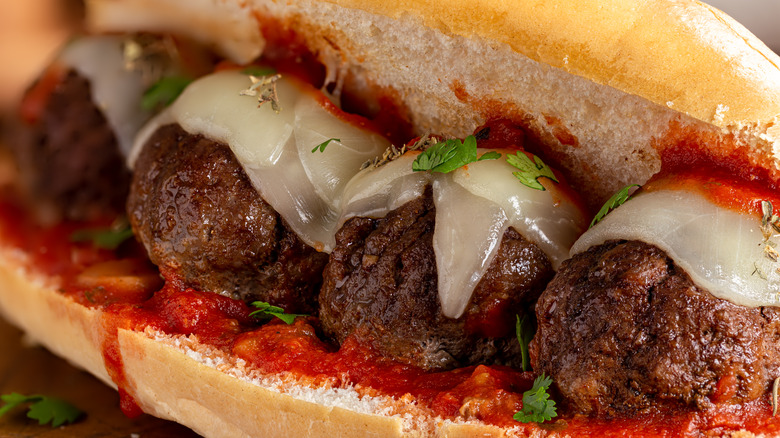What's Really In The Meatballs At Subway?
Subway's slogan is "Eat fresh," but ever since that one film about commercial meat production, we're probably all a little skeptical of exactly what questionable ingredients are going into our favorite fast foods. So if you've ever been halfway through chowing down on a meatball sub and then stopped and thought, 'Hmm — what unpronounceable ingredients am I unknowingly ingesting?' we've got some good news for you. The ingredient list for Subway meatballs isn't that long, and it's pretty standard.
Although the meatballs were once made with beef as the only meat base, they now include a beef and pork mixture, as well as wheat breadcrumbs, water, textured soy protein concentrate, onion, garlic, salt, parsley, soybean oil, something simply labeled "spice," and Romano cheese. They're topped with marinara sauce, which includes tomato puree, diced tomatoes, sugar, soybean oil, salt, citric acid, modified cornstarch, onion powder, and herbs and spices. At one point, the sandwich chain also offered a vegetarian meatball via a partnership with Beyond Meat's meatless meatballs, made with a plant-based protein, but the option was phased out in mid-2022.
An ingredient deep dive
Most of the ingredients on that list are pretty common, to the point where you probably have them stored away in your pantry or your fridge. But there are a couple of oddballs in the mix — citric acid, soybean oil, and textured soy protein concentrate, to name a few. So let's satiate your curiosity with a little deep-dive: What are these extra items, and why are they included?
Citric acid is an acid originally derived from lemons (and now manufactured from a kind of mold) that is often used as a preservative in commercially produced food. It is one of the most common ingredients in fast food and helps the sauce for your sub stay fresh while it waits to be slathered onto your sandwich. As for soybean oil, that's actually just a fancy name for vegetable oil, which is a popular ingredient for both at-home cooking and fast food establishments. Finally, soy protein concentrate, which is made by extracting water-soluble carbohydrates from processed soy flour — which, in turn, is made by grinding up the residue of de-hulled soybeans. Soy is used to make several of the most popular plant-based meat replacements and can be textured to create a more similar texture to meat products.
There you have it — meatballs demystified. Nothing on this list is too out-of-the-ordinary, and if you want to know more, a simple search can help explain why meat and spices aren't the only items on the list. But if you really want to know what's in your food? Try making meatballs at home with these 11 hacks.

